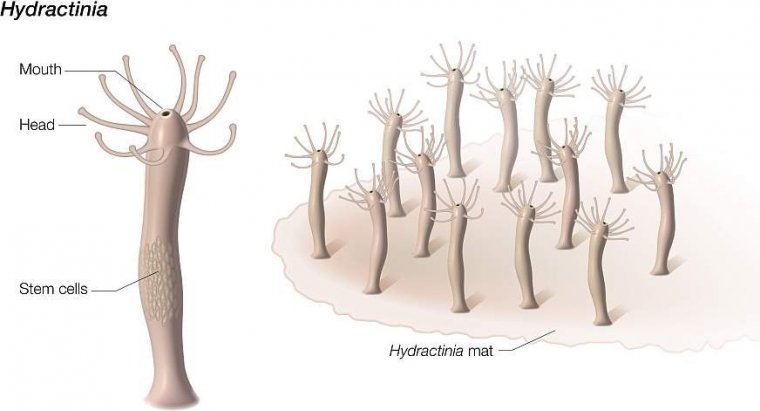| Health / Health News |
Scientists discover clues to aging and healing from a squishy sea creature
Insights into healing and aging were discovered by National Institutes of Health researchers and their collaborators, who studied how a tiny sea creature regenerates an entire new body from only its mouth.

Diagram showing the composition of the Hydractinia symbiolongicarpus. Photo: Darryl Leja/National Human Genome Research Institute
The researchers sequenced RNA from Hydractinia symbiolongicarpus, a small, tube-shaped animal that lives on the shells of hermit crabs.
Just as the Hydractinia were beginning to regenerate new bodies, the researchers detected a molecular signature associated with the biological process of aging, also known as senescence.
According to the study, Hydractinia demonstrates that the fundamental biological processes of healing and aging are intertwined, providing new perspective on how aging evolved.
Untangling the evolutionary origins of fundamental biological processes, such as aging and healing, is essential to understanding human health and disease. Humans have some capacity to regenerate, like healing a broken bone or even regrowing a damaged liver.
Some other animals, such as salamanders and zebrafish, can replace entire limbs and replenish a variety of organs.
However, animals with simple bodies, like Hydractinia, often have the most extreme regenerative abilities, such as growing a whole new body from a tissue fragment.
A regenerative role for senescence stands in contrast to findings in human cells. “Most studies on senescence are related to chronic inflammation, cancer and age-related diseases,” said Andy Baxevanis, Ph.D., senior scientist at NHGRI and an author of the study.
“Typically, in humans, senescent cells stay senescent, and these cells cause chronic inflammation and induce aging in adjacent cells. From animals like Hydractinia, we can learn about how senescence can be beneficial and expand our understanding of aging and healing.”
Previously, researchers found that Hydractinia has a special group of stem cells for regeneration.
Stem cells can transform into other types of cells, and are therefore useful for creating new body parts. In humans, stem cells mainly act in development, but highly regenerative organisms like Hydractinia use stem cells throughout their lifetimes.
Hydractinia stores its regeneration-driving stem cells in the lower trunk of its body. However, when the researchers remove the mouth — a part far from where the stem cells reside — the mouth grows a new body.
Unlike human cells, which are locked in their fates, the adult cells of some highly regenerative organisms can revert into stem cells when the organism is wounded, though this process is not well understood.
The researchers therefore theorized that Hydractinia must generate new stem cells and searched for molecular signals that could be directing this process.
When RNA sequencing pointed to senescence, the researchers scanned the genome of Hydractinia for sequences like those of senescence-related genes in humans. Of the three genes they identified, one was “turned on” in cells near the site where the animal was cut.
When the researchers deleted this gene, the animals’ ability to develop senescent cells was blocked, and without the senescent cells, the animals did not develop new stem cells and could not regenerate.
The researchers tracked the senescent cells in Hydractinia to find how this animal circumvents the harmful effects of senescence.
Unexpectedly, the animals ejected the senescent cells out of their mouths.
While humans can’t get rid of aging cells that easily, the roles of senescence-related genes in Hydractinia suggest how the process of aging evolved. (National Institutes of Health)
YOU MAY ALSO LIKE





